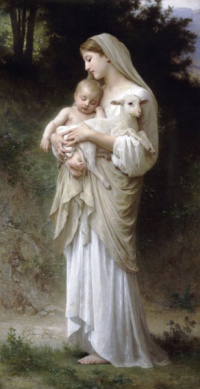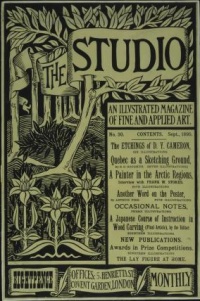1893
From The Art and Popular Culture Encyclopedia
(Difference between revisions)
| Revision as of 14:52, 13 February 2012 M-howard1@live.co.uk (Talk | contribs) ← Previous diff |
Revision as of 14:57, 13 February 2012 M-howard1@live.co.uk (Talk | contribs) Next diff → |
||
| Line 10: | Line 10: | ||
| === Music === | === Music === | ||
| *''[[After the Ball (song)|After the Ball]]'' by George J. Gaskin | *''[[After the Ball (song)|After the Ball]]'' by George J. Gaskin | ||
| + | *''A.O.O.S. March'' by Foh's 23rd Regiment Band of New York | ||
| === Film === | === Film === | ||
| *"Une mort de Marie Stuart" by [[Edmon Khun]] | *"Une mort de Marie Stuart" by [[Edmon Khun]] | ||
Revision as of 14:57, 13 February 2012

Innocence (1893) by William-Adolphe Bouguereau: Both young children and lambs are symbols of innocence
|
Related e |
|
Featured: |
Contents |
Art and culture
- Krafft-Ebing first uses the term "homosexual"
- In a letter to Franz Mehring, Friedrich Engels coins false consciousness: "Ideology is a process accomplished by the so-called thinker. Consciously, it is true, but with a false consciousness."
Music
- After the Ball by George J. Gaskin
- A.O.O.S. March by Foh's 23rd Regiment Band of New York
Film
- "Une mort de Marie Stuart" by Edmon Khun
- May 9 - In America, Thomas Edison holds the first public exhibition of films shot using his Kinetograph at the Brooklyn Institute. Unfortunately, only one person at a time could use his viewing machine, the Kinetoscope.
Literature
- Salome by Oscar Wilde published in French
- Teleny
- Gynecocracy by anonymous
- La Fleur Lascive Orientale, translated by Leonard Smithers]
Non fiction
- The Criminal Woman by Cesare Lombroso (La donna delinquente)
- Arthur Symons "The Decadent Movement in Literature" in Harper's New Monthly Magazine
- G. A. Peirson, Human Monstrosities (Philadelphia: Lea Brothers, 1893).
Visual culture
- World's Columbian Exhibition of 1893 in Chicago .
- 'Psyche at Nature's Mirror' by Paul Thumann, first published in Munsey's December 1893 issue.
- Studio Magazine
- The Scream by Edvard Munch
- Singulier Animal by Armand Rassenfosse
Architecture
- Hôtel Tassel, beginning of construction by Victor Horta
- Saltair, completed in 1893
Births
- Dorothy Sayers (1893-1957)
- Raymond Loewy (1893-1986)
- Mae West (1893 – 1980)
- Bill Tilden
- I. A. Richards (1893-1979), literary critic (The Meaning of Meaning)
- Conrad Veidt (1893 – 1943)
- George Grosz (1893 - 1959)
- Maria Jolas (1893- 1987)
- Samuel Roth (1893 - 1974)
- Norman Bel Geddes (1893-1958)
- Pitigrilli (1893 - 1975)
Deaths
- Guy de Maupassant (1850 - 1893)
- Jean-Martin Charcot (1825 - 1893), French neurologist
- José Zorilla (1817-1893)
Unless indicated otherwise, the text in this article is either based on Wikipedia article "1893" or another language Wikipedia page thereof used under the terms of the GNU Free Documentation License; or on research by Jahsonic and friends. See Art and Popular Culture's copyright notice.



